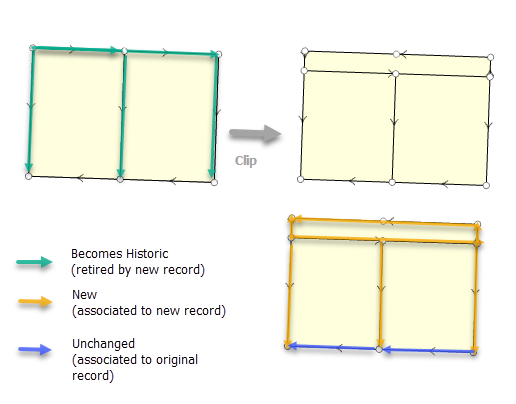New remainder parcels can be created when parcels overlay and clip underlying parcels. When parcels partially overlay underlying parcels, the areas covered by the overlying parcels are removed or clipped from the underlying parcels. The areas that remain are the remainder parcels.
Use the Clip tool  in the Tools gallery on the Parcel Record Workflows tab to create remainder parcels.
in the Tools gallery on the Parcel Record Workflows tab to create remainder parcels.
Learn more about the Clip tool
When creating remainder parcels in a record-driven workflow, use the Discard (Remainder) option in the Clip pane. The area that intersects the clip parcel is saved as historic, and the remainder parcel is associated with the active parcel record.
Clip parcels in a record-driven workflow
When clipping and creating remainder parcels in a record-driven workflow, parcel data is updated as follows:
- The clipping parcel and remainder parcel are associated with the active record, which is the parcel record that created them.
The Created By Record field of the clipping parcel and remainder parcel is populated with the GlobalID of the active parcel record.
- The original parcel that was clipped is set as historic.
The Retired By Record field of the original parcel is populated with the GlobalID of the record that created the new and remainder parcel.
- If there are COGO dimensions on the lines of the parent parcels being clipped, the COGO Type field of the remainder parcel lines is set to Computed and COGO distances are proportioned.
- The Stated Area field of a remainder parcel is calculated if the clipping parcel is completely contained in the parent parcel and the Stated Area attribute exists on the parent parcel.
- User-populated attributes of the original parcel are transferred to the new remainder parcel.
To clip parcels in a record-driven workflow, the general steps are as follows:
- Create the parcel record and set it as active in the map.
- Create and align the new parcels that will clip the existing parcels.
- Select the new parcels and click Clip
 in the Tools gallery on the Parcel Record Workflows tab.
in the Tools gallery on the Parcel Record Workflows tab. - In the Clip pane, choose the Discard (Remainder) option. Click the Target Features tab, and select the parcels you want to clip.See Split parcels using metes and bounds to learn more about clipping and creating remainder parcels.
Parcel features
When new parcels clip existing parcels, parcel features are updated as follows:
- Boundary lines that are clipped by the new parcel are retired as historic. New boundary lines are created for the clip parcel and the remainder parcels. The Created By Record field of the new parcel lines is populated with the GlobalID of the active parcel record.
- Boundary lines that are no longer used by any other adjacent parcels are retired as historic. The Retired By Record field of the parcel lines is populated with the GlobalID of the active record. This occurs, for example, when there are overlapping lines for adjacent boundaries, that is, each parcel has its own set of lines and does not share boundaries with adjacent parcels.
- Boundary lines that partially define the parcels being clipped and are in use by other adjacent parcels are retired as historic. New split boundaries are created for the clip and remainder parcels.
- Shared boundaries that were not altered by the clip remain unchanged and associated with the original record that created them.

Clip parcels outside of a record
In the parcel fabric, remainder parcels can be created with or without an active record in the map. When clipping parcels without an active record in the map, parcel history is not tracked and parcels are not associated with the records that created or retired them. Clipping parcels without an active record is done when performing data quality and cleanup edits on your parcel fabric.